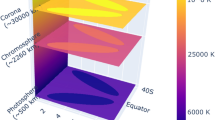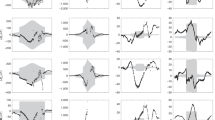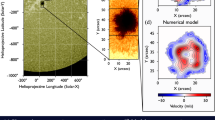Abstract
The most striking feature of the Sun's magnetic field is its cyclic behaviour. The number of sunspots, which are dark regions of strong magnetic field on the Sun's surface, varies with a period of about 11 years. Superposed on this cycle are secular changes that occur on timescales of centuries and events like the Maunder minimum in the second half of the seventeenth century, when there were very few sunspots1,2. A part of the Sun's magnetic field reaches out from the surface into interplanetary space, and it was recently discovered3 that the average strength of this interplanetary field has doubled in the past 100 years. There has hitherto been no clear explanation for this doubling. Here we present a model describing the long-term evolution of the Sun's large-scale magnetic field, which reproduces the doubling of the interplanetary field. The model indicates that there is a direct connection between the length of the sunspot cycle and the secular variations.
This is a preview of subscription content, access via your institution
Access options
Subscribe to this journal
Receive 51 print issues and online access
$199.00 per year
only $3.90 per issue
Buy this article
- Purchase on Springer Link
- Instant access to full article PDF
Prices may be subject to local taxes which are calculated during checkout


Similar content being viewed by others
References
Ribes, J. C. & Nesme-Ribes, E. The solar sunspot cycle in the Maunder minimum AD1645 to AD1715. Astron. Astrophys. 276, 549–563 (1993).
Beer, J., Blinov, A., Bonani, G., Hofmann, H. J. & Finkel, R. C. Use of 10Be in polar ice to trace the 11-year cycle of solar activity. Nature 347, 164–166 (1990).
Lockwood, M., Stamper, R. & Wild, M. N. A doubling of the Sun's coronal magnetic field during the past 100 years. Nature 399, 437– 439 (1999).
Harvey, K. L. & Zwaan, C. Properties and emergence of bipolar active regions. Sol. Phys. 148, 85– 118 (1993).
Sheeley, N. R. in The Solar Cycle (ed. Harvey, K. L.) 1–13 (Astronomical Society of the Pacific, ASP Conf. Series Vol. 27, San Francisco, 1992).
Wang, Y. M. & Sheeley, N. R. The rotation of photospheric magnetic fields: A random walk transport model. Astrophys. J. 430, 399–412 (1994).
Wang, Y.-M., Lean, J. & Sheeley, N. R. The long-term variation of the Sun's open magnetic flux. Geophys. Res. Lett. 27, 505– 508 (2000).
Wang, Y.-M., Sheeley, N. R. & Lean, J. Understanding the evolution of the Sun's open magnetic flux. Geophys. Res. Lett. 27, 621– 624 (2000).
Schrijver, C. J. et al. Large-scale coronal heating by the small-scale magnetic field of the Sun. Nature 394, 152– 154 (1998).
Howard, R. & Labonte, B. J. Surface magnetic fields during the solar activity cycle. Sol. Phys. 74, 131–145 (1981).
Harvey, K. L. in Solar Surface Magnetism (eds Rutten, R. J. & Schrijver, C. J.) 347–363 (Kluwer, Dordrecht, 1994).
Livingston, W. C., Harvey, J., Slaughter, C. & Trumbo, D. Solar magnetograph employing integrated diode arrays. Appl. Opt. 15, 40–52 ( 1976).
Schrijver, C. J. & Harvey, K. L. The photospheric magnetic flux budget. Sol. Phys. 150, 1– 18 (1994).
Chapman, G. A., Cookson, A. M. & Dobias, J. J. Solar variability and the relation of facular to sunspot areas during solar cycle 22. Astrophys. J. 482, 541–545 (1997).
Fligge, M., Solanki, S. K., Unruh, Y. C., Fröhlich, C. & Wehrli, C. A model of solar total and spectral irradiance variations. Astron. Astrophys. 355, 709–718 (1998).
Dicke, R. H. Solar luminosity and the sunspot cycle. Nature 280, 24–27 (1979).
Hoyng, P. Is the solar cycle timed by a clock? Sol. Phys. 169 , 253–264 (1996).
Wang, Y. M. & Sheeley, N. R. Solar implications of ULYSSES interplanetary field measurements. Astrophys. J. 447 , L143–L146 (1995).
Wilson, P. R., Altrock, R. C., Harvey, K. L., Martin, S. F. & Snodgrass, H. B. The extended solar activity cycle. Nature 333, 748– 750 (1988).
Harvey, K. L. in The Solar Cycle (ed. Harvey, K. L.) 335–367 (Astronomical Society of the Pacific, ASP Conf. Series Vol. 27, San Francisco, 1992).
Friis-Christensen, E. & Lassen, K. Length of the solar cycle: An indicator of solar activity closely associated with climate. Science 254, 698–700 ( 1991).
Svensmark, H. & Friis-Christensen, E. Variation of cosmic ray flux and global cloud coverage—a missing link in solar-climate relationships. J. Atmos. Terr. Phys. 59, 1225– 1232 (1997).
Svensmark, H. Influence of cosmic rays on Earth's climate. Phys. Rev. Lett. 81, 5027–5030 (1998).
Scherrer, P. H. et al. The Solar Oscillations Investigation—Michelson Doppler Imager. Sol. Phys. 162, 129– 188 (1995).
Acknowledgements
J. Beer and M. Lockwood provided the 10Be record and the record of the reconstructed interplanetary magnetic field, respectively. We are grateful to K. Schrijver for comments on this paper.
Author information
Authors and Affiliations
Corresponding author
Rights and permissions
About this article
Cite this article
Solanki, S., Schüssler, M. & Fligge, M. Evolution of the Sun's large-scale magnetic field since the Maunder minimum . Nature 408, 445–447 (2000). https://doi.org/10.1038/35044027
Received:
Accepted:
Issue Date:
DOI: https://doi.org/10.1038/35044027
This article is cited by
-
Reconstructing Sunspot Number by Forward-Modelling Open Solar Flux
Solar Physics (2024)
-
The Evolution of Multipole Moments for the Global Solar Magnetic Field
Solar Physics (2023)
-
Recalibration of the Sunspot-Number: Status Report
Solar Physics (2023)
-
A history of solar activity over millennia
Living Reviews in Solar Physics (2023)
-
Rate of Change of Large-Scale Solar-Wind Structure
Solar Physics (2022)
Comments
By submitting a comment you agree to abide by our Terms and Community Guidelines. If you find something abusive or that does not comply with our terms or guidelines please flag it as inappropriate.



